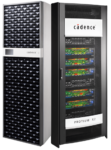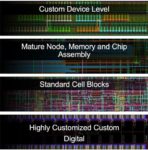In verification there is an ever-popular question, “When can we stop verifying?” The intent behind the question is “when will we have found all the important bugs?” but the reality is that you stop verifying when you run out of time. Any unresolved bugs appear in errata lists delivered with the product (some running to 100 or more … Read More
Electronic Design Automation
S2C Helps Client to Achieve High-Performance Secure GPU Chip Verification
S2C, a leading provider of FPGA-based prototyping solutions, has helped a client achieve high-performance secure GPU chip verification. With the help of S2C’s Prodigy prototyping solution, the client was able to start software development and hardware-software co-design early, leading to accelerated time-to-market… Read More
What’s New with Cadence Virtuoso?
It was back in 1991 that Cadence first announced the Virtuoso product name, and here we are 32 years later and the product is alive and doing quite well. Steven Lewis from Cadence gave me an update on something new that they call Virtuoso Studio, and it’s all about custom IC design for the real world. In those 32 years we’ve… Read More
Mitigating the Effects of DFE Error Propagation on High-Speed SerDes Links
As digital transmission speeds increase, designers use various techniques to improve the signal-to-noise ratio at the receiver output. One such technique is the Decision Feedback Equalizer (DFE) scheme, commonly used in high-speed Serializer-Deserializer (SerDes) circuits to mitigate the effects of channel noise and … Read More
AI Assists PCB Designers
Generative AI is all the rage with systems like ChatGPT, Google Bard and DALL-E being introduced with great fanfare in the past year. The EDA industry has also been keen to adopt the trends of using AI techniques to assist IC engineers across many disciplines. Saugat Sen, Product Marketing at Cadence did a video call with me to explain… Read More
Multi-Die Systems: The Biggest Disruption in Computing for Years
At the recent Synopsys Users Group Meeting (SNUG) I had the honor of leading a panel of experts on the topic of chiplets. The discussion was based on a report published by the MIT Technology Review Insights in cooperation with Synopsys. This is a very comprehensive report (12 pages) that is available online HERE.
Here is the preface… Read More
Hardware Root of Trust for Automotive Safety
Traveling by car is something that I take for granted and I just expect that my trips will be safe, yet our cars are increasingly using dozens of ECUs, SoCs and millions of lines of software code that combined together present a target for hackers or system failures. The Automotive Safety Integrity Levels (ASIL) are known by the letters:… Read More
Siemens EDA on Managing Verification Complexity
Harry Foster is Chief Scientist in Verification at Siemens EDA and has held roles in the DAC Executive Committee over multiple years. He gave a lunchtime talk at DVCon on the verification complexity topic. He is an accomplished speaker and always has a lot of interesting data to share, especially his takeaways from the Wilson Research… Read More
Taking the Risk out of Developing Your Own RISC-V Processor with Fast, Architecture-Driven, PPA Optimization
Are you developing or thinking about developing your own RISC-V processor? You’re not alone. The use of the RISC-V ISA to develop processors for SoCs is a growing trend. RISC-V offers a lot of flexibility with the ability to customize or create ISA and microarchitectural extensions to differentiate your design no matter your application… Read More
Optimizing Return on Investment (ROI) of Emulator Resources
Modern day chips are increasingly complex with stringent quality requirements, very demanding performance requirement and very low power consumption requirement. Verification of these chips is very time consuming and accounts for approximately 70% of the simulation workload on EDA server farms. As software-based simulators… Read More











Quantum Computing Technologies and Challenges